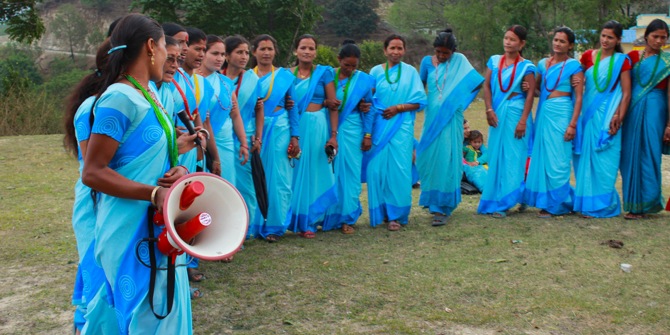 Nepal has committed to achieving the UN Sustainable Development Goals but this will be no easy task. Ashutosh M Dixit outlines how collaborative approaches which acknowledge the interlinkages between the SDGs and good monitoring and evaluation will be essential to achieving meaningful outcomes within the next decade and a half.
Nepal has committed to achieving the UN Sustainable Development Goals but this will be no easy task. Ashutosh M Dixit outlines how collaborative approaches which acknowledge the interlinkages between the SDGs and good monitoring and evaluation will be essential to achieving meaningful outcomes within the next decade and a half.
The UN’s 2030 Sustainable Development Agenda, with its Sustainable Development Goals (SDGs) and national indicators offers a historic opportunity for Nepal. The Himalayan nation has integrated the SDGs into the national plan, and hopes to achieve the goals in tandem with its aim of graduating to a middle income country by 2030.
However, achieving these ambitious goals will depend not only on the central government. The newly formulated Constitution of Nepal has devolved responsibilities to provincial and local governments, mostly related to aspects of poverty, agriculture, basic healthcare, education, and water and sanitation. In addition, civil society and the private sector must also take ownership of the development agenda in order to make a meaningful difference to people’s lives in less than a decade and a half. This article highlights key areas that policymakers and stakeholders need to consider going forward.
Expand economic opportunity and pro-employment growth
The Sustainable Development Goals represent a major leap forward in terms of aspirations when compared to the earlier Millennium Development Goals. The first goal ambitiously aims to eradicate poverty (SDG 1), rather than just reduce it. To achieve broader and more inclusive development, where income growth for the bottom 40 per cent of the population is higher than growth in GDP (SDG 10), Nepal needs to develop an ecosystem that generates opportunities at all levels where the top-line economic performance is translated into benefits at the bottom through employment, education and security. This means focusing beyond redistribution towards a broad-based expansion of economic opportunity. For instance, measures are needed to foster greater entrepreneurship for new business creation, incentivise companies to move from the informal to formal sector, make available quality vocational training, and improve access to finance.
Furthermore, a lack of opportunities has already resulted in large numbers of young Nepalis moving abroad to work. Those left behind are mostly in low skilled informal employment, something ILO describes as sporadic, poorly paid and falling outside the protection of law. It is high time that the country capitalises on the youth bulge in its demographic structure. It should introduce the pro-employment growth policies that can accommodate the stock of skilled and semi-skilled young people joining the labour force annually, facilitate the transition from informal work to formal work, and improve industrial relations in the economy (SDG 8).
Share responsibility: public, private and cooperatives
How private sector, cooperatives and households participate will have a major bearing on whether SDGs can be realised. The private sector is already beginning to link investments to sustainability objectives, apparent from private sector adoption of inclusive business approaches, green innovation, emissions reduction, and impact investing practices. To foster greater private sector interest in sustainable growth, the country must muster a common will between public and private, and produce a tangible output by enacting a Public Private Partnership (PPP) policy, and Viability Gap Funding (VGF) mechanisms. Moreover, there needs to be a shift in attitudes, and acceptance that responsibilities will have to be shared.
Nepal has made remarkable progress on several measures of civil engagement, from well-managed community forests to vibrant community radio stations. It is fair, therefore, to state that cooperatives and NGOs are becoming instrumental in women’s empowerment, sustainably managing the forest (SDG 15), financial inclusion, as well as proving valuable during disaster rehabilitation and recovery. They can contribute not only through resources pooled from communities, but also through ideas and solutions tailored to local contexts that might help achieve the SDGs. In addition to that, government-community partnership can ensure accountability of newly elected local governments by making sure their actions match their manifesto promises.

Identify SDG accelerators, and strengthen data monitoring
The SDGs are not mutually exclusive. To address the key development challenges, policymakers should identify interrelationships and synergies between the 17 SDGs and 169 targets. For instance, the degree to which absolute poverty is reduced will depend on the progress made on physical infrastructure in hinterlands of Nepal (SDG 9). Healthy lives will to a certain extent be linked to agriculture productivity (SDG 2). Food security (SDG 12) may have connection with education (SDG 4), while completing secondary school may help girls benefit from array of socio-economic returns such as empowerment (SDG 5), higher productivity and jobs. These benefits in turn are likely to have deeper connection with young child health in Nepal. Similarly the promotion of renewable energy (SDG 7) on the other hand may have positive impact on wellbeing of rural households in Nepal.
There are many such interlinkages which can foster effective change, the interdependencies should be assessed and accelerated through relevant national strategies and sectoral plans. Understanding how SDGs are interlinked, and examining goals from from multiple perspectives should help refine the policies, and plan for more effective action. For instance, an assessment on how gender equality could progress if the primary focus is education or health, or how the ministry responsible for water needs to cooperate with the forest and energy ministries to accelerate progress on both goals SDG 6 and 7, would help use of limited resources in more catalytic way, and efficiently materialise multiple objectives in the 2030 agenda.
Installing a strong monitoring system with a credible data base is crucial to measure and incentivise progress across the SDGs. The recently completed voluntary national review highlights that the monitoring of the outcome and impact level indicators is hampered by the lack of disaggregated information. It is understood that substantial changes are required to overcome the weaknesses of the existing statistical system as there is no comprehensive and distinct responsibility for the production of indicators amongst the ministries and Central Beaureu of Statistics (CBS). The National Strategy for the Development of Statistics (NSDS), a medium term plan which aims for reforming the National Statistical System (NSS) and establish a dedicated data monitoring statistical agency, needs be finalised and implemented as soon as possible. The establishment of dedicated agency to generate and process quality and standarised data will help keep track of the SDGs trajectories and help to monitor and evaluate the progress.
Overall, the scale of the issues and challenges that Nepal confronts demands extraordinary commitment from stakeholders at all levels. The 2030 agenda has shown the path to building a just, peaceful, and lasting prosperity. Now it’s up to Nepal to implement it and graduate as a sustainable middle income country the next 15 years.
This article gives the views of the authors, and not the position of the South Asia @ LSE blog, nor of the London School of Economics. Please read our comments policy before posting.
About the Author
Ashutosh M Dixit is an Economist based in Nepal. He has worked as a consultant for the NPC (The National Planning commission)-Government of Nepal, UN-ESCAP, UNDP, OECD, and the World Bank-IFC. Ashutosh is a graduate in Economics from the Australian National University (ANU), he studied in Australia as an Australian Award Scholar. Additionally, he completed an executive education course on Economic Development from the Harvard Kennedy School of Government.








Excellent analysis. Well done !!